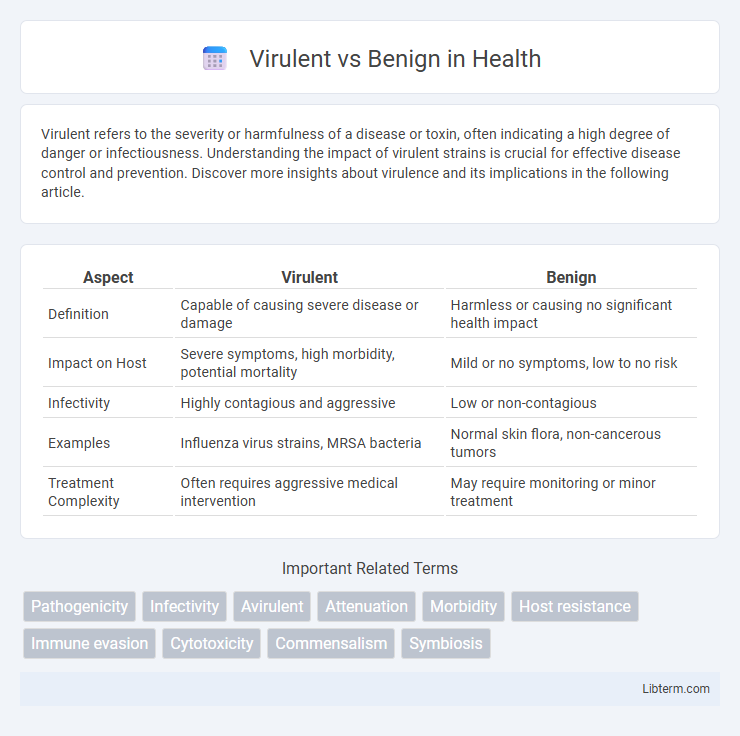Virulent refers to the severity or harmfulness of a disease or toxin, often indicating a high degree of danger or infectiousness. Understanding the impact of virulent strains is crucial for effective disease control and prevention. Discover more insights about virulence and its implications in the following article.
Table of Comparison
| Aspect | Virulent | Benign |
|---|---|---|
| Definition | Capable of causing severe disease or damage | Harmless or causing no significant health impact |
| Impact on Host | Severe symptoms, high morbidity, potential mortality | Mild or no symptoms, low to no risk |
| Infectivity | Highly contagious and aggressive | Low or non-contagious |
| Examples | Influenza virus strains, MRSA bacteria | Normal skin flora, non-cancerous tumors |
| Treatment Complexity | Often requires aggressive medical intervention | May require monitoring or minor treatment |
Understanding Virulence and Benignity
Virulence refers to the degree of pathogenicity or severity of a microorganism's ability to cause disease, often linked to factors like toxin production, infection dose, and host immune response. Benignity describes organisms or conditions that cause little to no harm or symptoms, indicating minimal or no pathogenic effect on the host. Understanding virulence and benignity is crucial for developing targeted treatments, predicting disease outcomes, and managing infection control effectively.
Key Differences Between Virulent and Benign Agents
Virulent agents cause severe disease by effectively invading host tissues, evading the immune system, and producing toxins, whereas benign agents typically coexist without causing harm or disease symptoms. Virulence is characterized by factors such as pathogenicity, aggression in host invasion, and the ability to cause significant tissue damage, while benign agents exhibit low or no pathogenic traits and often maintain a commensal or symbiotic relationship with the host. Understanding the molecular mechanisms behind virulence, including gene expression related to toxin production and adhesion factors, is critical for distinguishing these agents within clinical and environmental contexts.
Mechanisms of Virulence
Virulent pathogens employ mechanisms such as toxin production, immune evasion, and adhesion to host cells to establish infection and cause disease. These mechanisms enable them to invade tissues, disrupt normal cellular functions, and resist host immune responses. In contrast, benign microbes lack these aggressive traits and typically coexist with the host without causing harm.
Characteristics of Benign Organisms
Benign organisms typically exhibit low pathogenicity and do not cause harm or disease to their host, often existing in a symbiotic or commensal relationship. They possess limited or no virulence factors, such as toxins or aggressive enzymes, which distinguishes them from virulent counterparts. Their growth is usually controlled by the host immune system, allowing coexistence without eliciting significant immune responses or tissue damage.
Factors Influencing Virulence
Virulence is influenced by factors such as pathogen load, genetic makeup, and the presence of specific virulence genes that enhance a microbe's ability to invade host tissues, evade immune responses, and produce toxins. Host factors including immune status, age, and genetic predisposition also play crucial roles in determining the severity of infection. Environmental conditions like temperature, humidity, and nutrient availability can modulate pathogen virulence expression and disease progression.
Clinical Implications of Virulent vs Benign Strains
Virulent strains of pathogens often lead to severe clinical manifestations, increased tissue damage, and higher morbidity rates compared to benign strains that typically cause mild or asymptomatic infections. Understanding the genetic and molecular differences between virulent and benign strains is crucial for developing targeted therapies and effective vaccines. Accurate strain identification informs clinical decision-making, infection control measures, and prognosis prediction in infectious disease management.
Diagnosis: Identifying Virulent and Benign Pathogens
Diagnosis of virulent and benign pathogens relies on molecular techniques such as PCR and genomic sequencing to detect specific virulence genes and markers. Phenotypic assays, including culture characteristics and host response variability, provide complementary differentiation by assessing pathogenic potential and severity. Accurate identification of virulence factors enables targeted treatment strategies and effective infection control measures.
Impact on Public Health
Virulent pathogens cause severe illness and rapid disease spread, leading to higher mortality rates and overwhelming healthcare systems. Benign microbes typically result in mild or asymptomatic infections, posing less threat to public health and reducing the burden on medical resources. Understanding the virulence of a pathogen is crucial for developing effective control measures and allocating public health resources efficiently.
Preventive Strategies and Treatments
Preventive strategies for virulent infections emphasize vaccination, early detection, and stringent hygiene practices to reduce transmission and severity. Benign conditions often require minimal intervention, focusing on symptom management and maintaining a healthy lifestyle to prevent complications. Treatment of virulent diseases involves aggressive antimicrobial therapies and supportive care, while benign cases typically respond well to conservative treatments and regular monitoring.
Future Research and Emerging Trends
Future research on virulent versus benign pathogens emphasizes genomic sequencing and machine learning algorithms to predict disease severity and transmission patterns. Emerging trends include the development of targeted antivirals and vaccines based on pathogen virulence factors, as well as advanced surveillance systems integrating big data analytics for early outbreak detection. Innovations in CRISPR-based diagnostics and synthetic biology offer promising tools to engineer less virulent strains, potentially transforming treatment and prevention strategies.
Virulent Infographic

 libterm.com
libterm.com